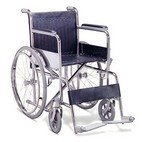Well, its been a while since my last post for although things still change, it is far to slow for my liking. This has been a challenging summer on several fronts.
No Continuing Physiotherapy:
Those who have followed this blog know that I no longer receive physiotherapy. Not my choice however with all levels of government crying poverty, funding cuts are passed on to the community. Community hospitals which once provided the level of expertise in physiotherapy that an injury as severe as mine requires now had to deal with a frozen operational budget. The provincial government however had the funds to create LHINs (Local Hospital Integration Networks) which were are an "arms length" agency that in a sense does the government's dirty work for them. They suggest what services should be eliminated from hospitals under the premise that they are already available in the community by private providers. This in theory would duplication of services available in the community and funds saved could be channeled into core hospital programs. Of course governments often fail to see the big picture. Hospitals provided that level of expertise (spinal cord, stroke, brain injury) that private community physiotherapy clinics who deal with primarily with sports injury or minor trauma rarely see. Expertise developed not only through continuous encounters with people suffering from such catastrophic injuries but also in the acquisition and use of specialized equipment to aid in rehabilitation which smaller private clinics simply can't justify buying.
With the closure of hospital physiotherapy (and other) clinics, patients either terminated their therapy or attempted to find nearby private clinics which would continue their therapy on some level. It was quickly apparent that the sudden influx of new clients quickly overwhelmed the private clinics.
The irony was that outpatient physiotherapy clinics actually brought outside monies (insurance or self-pay) into the hospital, above and beyond the government funding. Go figure!
*the private clinic I attended over the winter of 2009-2010 was chosen primarily because of location.(it was nearby). Perhaps more specialized clinics could be found on the other side of the city or in the next town however travel time was a significant factor, dependant on public disability transportation service scheduling.
The private clinic I attended had no handicapped automatic door opener, had no parallel bars and had to rent a walker for my use. Hardly equipped for my needs.
Disability Transport Goes On Strike:
As mentioned above, provincial governments have cried poverty and indicated that budgets would be frozen for the foreseeable future. Yet, at a time when most are grateful just to hang onto their jobs, the union for the public disability transportation service which takes me to and from work each day coerced members into strike action. So in mid summer they took to the picket line leaving the non-unionized transit management scrambling to meet their obligation. Rides were quickly outsource to a private cab company that usually just handles the overflow from the provincially funded disability transportation service. While I was prepared to leave my powerchair at work and have my wife shuttle me back and forth by car with my manual chair, the cab service worked extremely well, so much so that my times were usually better resulting in a shorter commute. While priority for rides was assigned by necessity - medical appointments, work, and leisure, I never was without timely transportation. After about six weeks the strike ended with not much being accomplished. Drivers sacrificed a pay-cheque for this time away however did retain their benefits in the new contract which was a big issue. The transportation agency probably saved some money on salaries, fuel and vehicle maintenance but as they had to pay the cab company for service, the savings were probably not substantial. It was a lose-lose-lose situation between drivers, management and clients...
New Powerchair:
It has been over six years since my injury and my acquisition of an electric wheelchair. The chair was presented to me while an inpatient at Toronto's Lyndhurst Rehabilitation Hospital. I had no input as to the vendor, model or specification as with no previous experience, I relied on the hospital's expertise. All in all, they did a fine job in matching the chair to the person (me) - or perhaps, because I had no previous experience with a powerchair, whatever I was given seemed right. I had nothing to compare it to.
Well, after six years of use and abuse, my first and current chair "on it's last legs" (no pun intended). The detachable leg supports have been bent, straightened, re-bent, replaced and re-bent. They splay out and twist in, stick out and catch on any obstacle, however small, that extends above flat ground. The arm rests were some of the first luxury items to go, Shredded off like cheese on a grater while rubbing along the sides of the bus lift. The tilt motor stopped working years ago - once considered a necessity to shift my weight in order to prevent pressure sores. Skin issues never materialized and so when the motor stopped operating, I decided against submitting a claim to my insurance company for unreasonable cost of replacing the unit. The front and back castors rubber treads are all but warn off. The original battery still takes a charge but loses it much more quickly. The chair creaks and groans but continues to run in spite of the abuse I inflict on it daily. However, I cannot continue to push my luck It was time to look into getting a new powerchair.
Am I entitled?
When I received my first powerchair while completely paralyzed from the chest down. Things have improved greatly since my discharge from the hospital to where now I can even wiggle a few toes to some degree. As I work at a hospital, I see wheelchair bound people daily, some elderly, some with visible physical deficiencies, yet using manual wheelchairs. I had to wonder if it was their own choice to propel themselves using their own power, or did they settle for the less expensive manual chair because of their limited finances? Even with the provincial government's ADP's assistance (Assisted Devices Program), the 25% cost the client must pay can be prohibitive.
Even with my decent income, the full cost of a new powerchair would make it out of reach for me.(my first powerchair with tilt cost $18,000) - A "Catch 22" situation - I would be working only to pay for the chair and I would need the chair only so that I could work.
So the question was;
As I have excellent upper body strength and am able to propel a manual chair with ease, would I still qualify for ADP assistance for a powerchair, in light of many other people with less ability using manual chairs as their sole source of mobility? I would find it a significant financial burden to buy one without their assistance yet I need a powerchair to do my job. I need one hand free to carry items and I need the braking mechanism in the powerchair so that I can brace against it to stand up (a manual chair's brakes are not sufficient to keep it from rolling back.
The choices are - would the government prefer to assist my purchase of a powerchair which would keep me a productive taxpaying citizen, or to deny assistance, leaving me unable to do my job which would result on my falling back on disability and having the taxpayers support me.
The Result:
With the help of an acquaintance, I contacted a sympathetic ADP authorized occupational therapist. She assisted in getting authorization for the ADP assisted purchase of a new chair. As a seating specialist she also recommended and provided seating much superior to what I currently was using. She contacted the sales representative for a powerchair supplier and started the process. I'll have more about my chair selection process in an upcoming post.
Saturday 8 September 2012
Subscribe to:
Posts (Atom)







.jpg)
